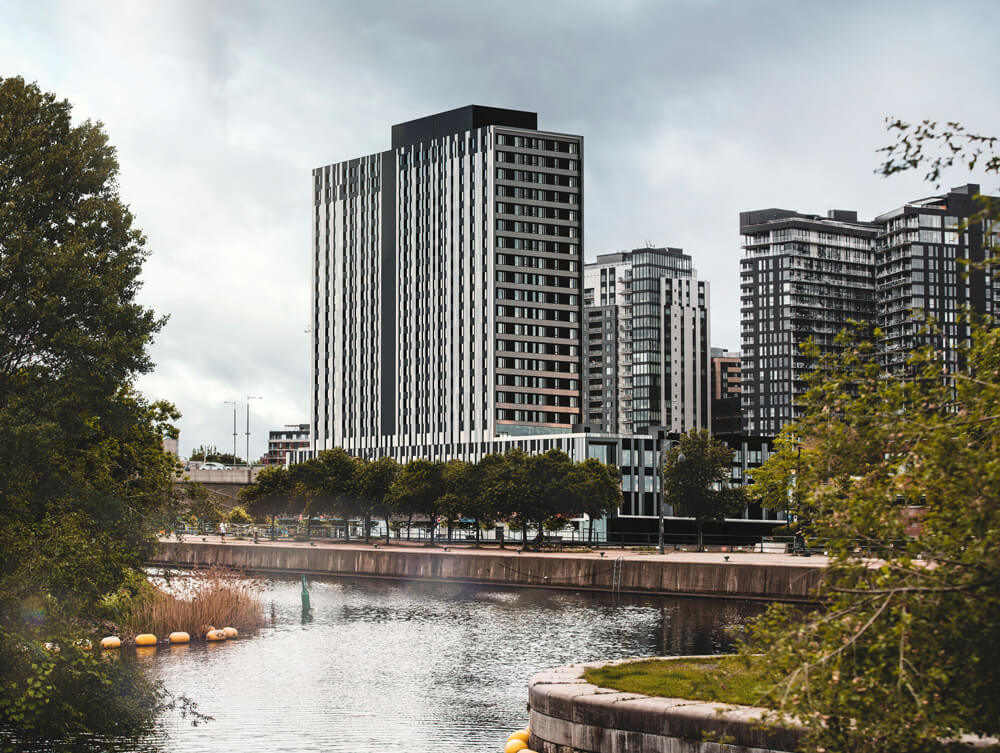Global climate leaders are now recognising that climate change is directly impacting communities, acknowledging that adaptations are needed to mitigate the negative effects that extreme weather events are having at a local level. Through the introduction of the Loss & Damage Fund, a commitment made at the recent COP27 in November, global leaders are starting to make such necessary changes to global infrastructure.
Across the Real Estate industry, adaptation is urgently needed. Urban centres, where population density, infrastructure demand and building occupancy is the highest, must be a priority focus for all stakeholders in the global climate challenge. Cities will need to be prepared for extreme weather, including heat, wind and flooding which are now becoming the new normal. Of course, we must not forget the urgency of mitigating the impact of the built environment on climate change, which contributes to 40% of global greenhouse emissions.
At Ivanhoé Cambridge, we are committed to achieving net zero carbon by 2040, whilst working to increase the resilience of our global portfolio against physical climate change risks. However, we know that we cannot do this alone, we need to collaborate with governments, urban planners and businesses to make our cities and communities climate resilient.
Resilience First
It is our belief that collective action is more powerful than individual action, where global communities must come together to share innovation and action real change. That’s why we’re pleased to announce that we have joined Resilience First, the global network of businesses and partners designed to share knowledge and shape practice to drive climate resilience at scale.
Sustainable action is our priority, and we’re investing in innovation and prioritising decarbonisation to future-proof our assets to the climate needs of tomorrow. By joining initiatives like Resilience First, we can take part in critical ideas sharing, working together to update and build existing global infrastructure that is both resilient against climate change and sustainable.
Resilience First has recently published scientific reports to help industry actors understand Urban Climate Action, calling for change and providing practical guidelines on how we, the Real Estate industry, can adapt our buildings in cities. This is crucial, where the high concentration of people, inadequate buildings and poor infrastructure, as well as the intersection of these issues with poverty, vulnerability, and inequality, has posed a complex challenge.
Adapting to climate risks
Within their reports, Resilience First has identified multiple feasible options that can mitigate the impact of urban areas on the environment, while building resilience. Among these options are energy efficiency improvements, expanding access to renewable energy and improving public transport infrastructure. Improving these as an initial step can help cities meet Sustainable Development Goals (SDGs) as outlined by the UN, improving outcomes in health, energy security and equity. Updating this infrastructure will also create new green job opportunities and raise domestic incomes.
“Re-wilding” or bringing back nature to cities can also have a key role to play, where introducing green and open spaces, including urban forests and agriculture, wetlands and water-sensitive design can have multiple positive benefits, including lowering flood risk, limiting urban heat and reducing air pollution – all of which can help cities enhance their resilience to climate change.
Ivanhoé Cambridge has started to do this through recent investments and projects, including Haleco in Montreal, focusing on urban regeneration, biodiversity and community, where 57% of the land the project occupies will be revegetated.

Building resilience now
Urban adaptation is happening, but significant gaps remain. While over 100 cities of varying sizes and locations have developed climate adaptation plans and a further 170 nations include adaptation in their policies and processes, the current commitments will not adequately address the risks faced by urban areas.
That’s why we must take proactive measures and collaborate to instigate real change. As a real estate owner with a global portfolio of both urban and local level investments, we know that a majority of our assets will still be standing in 50 years, and it is critical that we act now to build a safe, sustainable and resilient future for our building’s inhabitants.

